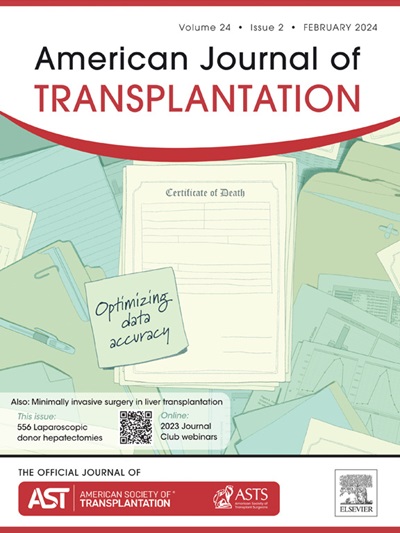肾移植后严重缺血和再灌注损伤会诱导肾脏祖细胞中 LHX1 的表观遗传失活。
IF 8.9
2区 医学
Q1 SURGERY
引用次数: 0
摘要
严重的缺血再灌注损伤(IRI)会导致急性和慢性肾脏异体移植损伤。由于减少损伤的治疗干预措施有限,如何促进肾脏修复的研究引起了人们的极大兴趣。为了解决这个问题,我们对从已故(重度 IRI)和活体(轻度 IRI)供体人肾移植尿液中分离出来的祖细胞进行了全基因组转录组和表观基因组分析,发现 LIM homebox-1 (LHX1) 是一个受表观基因调控的基因,其表达取决于 IRI 的严重程度。利用 IRI 小鼠模型,我们观察到 IRI 严重程度、LHX1 启动子超甲基化和 LHX1 基因表达之间的关系。通过功能研究,我们证实 LHX1 的表达参与了肾小管上皮细胞的增殖和肾祖细胞荚膜的分化。我们的研究结果提供了证据,证明严重的IRI可能会通过表观遗传信号降低肾脏修复的内在机制。本文章由计算机程序翻译,如有差异,请以英文原文为准。
Severe ischemia-reperfusion injury induces epigenetic inactivation of LHX1 in kidney progenitor cells after kidney transplantation
Severe ischemia-reperfusion injury (IRI) causes acute and chronic kidney allograft damage. As therapeutic interventions to reduce damage are limited yet, research on how to promote kidney repair has gained significant interest. To address this question, we performed genome-wide transcriptome and epigenome profiling in progenitor cells isolated from the urine of deceased (severe IRI) and living (mild IRI) donor human kidney transplants and identified LIM homeobox-1 (LHX1) as an epigenetically regulated gene whose expression depends on the IRI severity. Using a mouse model of IRI, we observed a relationship between IRI severity, LHX1 promoter hypermethylation, and LHX1 gene expression. Using functional studies, we confirmed that LHX1 expression is involved in the proliferation of epithelial tubular cells and podocyte differentiation from kidney progenitor cells. Our results provide evidence that severe IRI may reduce intrinsic mechanisms of kidney repair through epigenetic signaling.
求助全文
通过发布文献求助,成功后即可免费获取论文全文。
去求助
来源期刊
CiteScore
18.70
自引率
4.50%
发文量
346
审稿时长
26 days
期刊介绍:
The American Journal of Transplantation is a leading journal in the field of transplantation. It serves as a forum for debate and reassessment, an agent of change, and a major platform for promoting understanding, improving results, and advancing science. Published monthly, it provides an essential resource for researchers and clinicians worldwide.
The journal publishes original articles, case reports, invited reviews, letters to the editor, critical reviews, news features, consensus documents, and guidelines over 12 issues a year. It covers all major subject areas in transplantation, including thoracic (heart, lung), abdominal (kidney, liver, pancreas, islets), tissue and stem cell transplantation, organ and tissue donation and preservation, tissue injury, repair, inflammation, and aging, histocompatibility, drugs and pharmacology, graft survival, and prevention of graft dysfunction and failure. It also explores ethical and social issues in the field.

 求助内容:
求助内容: 应助结果提醒方式:
应助结果提醒方式:


